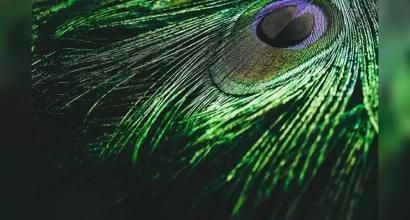... continued from the previous episode...
Śarvilaka brings Vasantesenā’s ornaments to Madanikā; she gathers the reality from him and sends the ornaments to Vasantesenā as though Cārudatta had himself sent them to her. Vasantesenā, who overhears the love conversation of the couple, is touched and unties Madanikā with Śarvilaka; she thus liberates Madanikā, who was her dāsī. As they head out in a cart, Śarvilaka hears that his friend Āryaka was trapped by Pālaka; he hurries to rescue him. In the meantime, Maitreya brings Dhūtādevī’s necklace to Vasantesenā claiming that Cārudatta had pawned away her ornaments in a gamble; he tells her that the necklace was meant as a replacement for the ornaments which she has now lost. (Act 4)
Vasantesenā comes to Cārudatta’s place and gives him her ornaments claiming that she had lost the gem necklace in a gamble. Cārudatta understands the real state of matter and is touched by Vasantesenā’s kind gesture. As it was dark and raining, Vasantesenā stays back at Cārudatta’s house that evening. (Act 5)
The next morning, Vasantesenā finds Cārudatta’s son Rohasena crying adamantly that he did not want a play cart made of clay but wanted a golden one instead; she consoles the child and puts her ornaments into his play cart. She then heads towards the dilapidated garden, the Puṣpa-karaṇḍaka as per Cārudatta’s instruction, and happens to climb onto śakāra’s cart by mistake. Cārudatta rescues Āryaka, who had escaped from his trap and drives him in his cart; on his way, he gets caught by two guards named Vīrakala and Nandaka; Candanaka had not only helped Āryaka escape, but had also given him his sword for his protection. (Act 6)
Cārudatta, who was expecting Vasantesenā to board his cart, is surprised to find Āryaka instead; he sends away Āryaka to safety in the same cart. (Act 7)
Vasantasenā mistakes the cart that was at Cārudatta’s door to be his and gets on to it, without realising that it was actually śakāra’s. It brings her to śakāra in the Puṣpa-karaṇḍaka garden. An argument ensues between śakāra and Vasantesenā, and śakāra is enraged. He tries to strangle her, pushes her to the ground, and covers her with dried leaves. A bhikṣu, who was Saṃvāhaka previously, happens to come there to wash his robes and finds Vasantesenā in that state; he rescues her. (Act 8)
Śakāra accuses Cārudatta of having killed Vasantesenā. A hearing takes place at the seat of justice, and Cārudatta is convicted of murder; the king decides to punish him by planting him on a spear[1]. (Act 9)
As caṇḍālas escort Cārudatta to the place of execution, the bhikṣu appears there with Vasantasenā. The king Pālaka learns that Vasantasenā is alive. Sthāvaraka declares that he was an eye-witness for śakāra killing Vasantasenā. In the meantime, Āryaka and others kill Pālaka and bring the kingdom under their control. Dhūtādevī learns that her husband Cārudatta is going to be executed and decides to enter fire; Cārudatta rushes to her and prevents her from ending her life. As per his request, the king forgives śakāra as well. The reigns of the kingdom are now held by the new king, Āryaka, and everyone’s life is uplifted. Vasantasenā, who was a prostitute so far, now becomes the new ‘bride’.[2] (Act 10)
It is interesting to note that the story of the first four acts of Mṛcchakaṭika is similar to that of the play Cārudatta (See page <>). The episodes, conversations, characters, and construction of the two plays are so similar that it almost feels like the two are slightly different readings[3] of the same original work. Therefore, many scholars are of the view that Cārudatta was composed first and Mṛcchakaṭika was based upon this earlier play. It is quite likely to be true.
There are two dimensions to the story of the Mṛcchakaṭika: the first is the social dimension connected with Vasantasenā and Cārudatta, and the second is the political dimension that involves Āryaka and Pālaka.[4] Between the plays Cārudatta and Mṛcchakaṭika, only the latter has this additional political dimension. If we can lay our hands on the entire play Cārudatta, assuming that parts of it are lost, we might be able to find the segment which captures the underlying political current as well. However, there is no semblance of political dimension in the form in which Cārudatta is available to us today. From this, a few scholars surmise that the poet Śūdraka created the Mṛcchakaṭika by adding the political dimension to Cārudatta, a play which he used as the substratum.
To be continued ...
The current series of articles is an enlarged adaption of Prof. A. R. Krishnasastri's Kannada treatise Saṃskṛta-nāṭaka. They are presented along with additional information and footnotes by Arjun Bharadwaj.
[1] Called śūlāropaṇa in ancient India
[2] Though Mṛcchakaṭika is a play, one can find reflections of India’s socio-political and cultural elements that were contemporary to the period of its composition. Paranjpe and Winternitz (G.I.I., Vol iii, pages 2-8-209) have undertaken studies on this aspect. The reader may take a look at the Mṛcchakaṭika compiled and published by Paranjpe, especially Appendix I. We have only put together the main storyline of the play here.
[3] i.e., they are pāṭhāntaras of each other.
[4] In many modern-day novels, we find a tale of love narrated to the backdrop of a bigger political story.











































